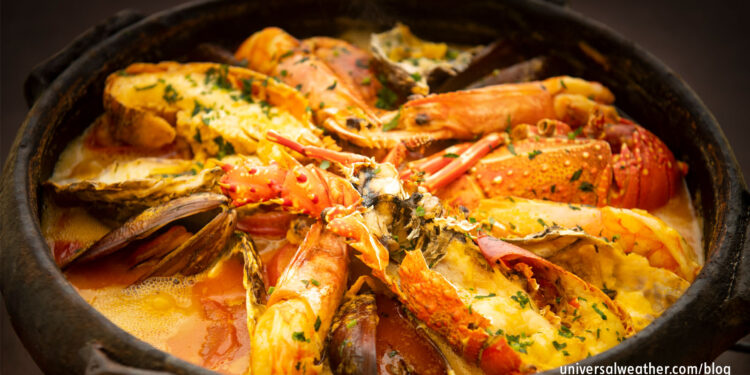Brazilian Flavor Influences – Part 2: Regional Cuisine for In-flight Catering

This is a post by author Richard Peterson. Richard is the general manager and executive chef for Air Culinaire Worldwide, with the headquartered kitchen in Tampa, Florida. Air Culinaire Worldwide also has kitchens in Aspen; Boston; Chicago; Dallas; Denver; Las Vegas; London; Long Beach; Miami; New York; Paris; San Francisco; Seattle; Van Nuys; West Palm Beach; and Washington, D.C. In addition, Air Culinaire Worldwide provides in-flight catering services at airports around the world via hundreds of catering partners. Richard is an expert in catering for business aviation and can be contacted at richardpeterson@airculinaire.com.
This business aviation blog post continues from our article last week, titled: “Brazilian Flavor Influences – Part 1: In-Flight Catering Options and Tips.”
While certain national cuisines are available throughout Brazil, each region has its own feature dishes and flavor profiles. Work with your in-flight caterer to source uniquely appealing cuisine choices from various regions of the country.
The following is an overview of what you need to know:
1. Eastern Brazil cuisine favors fish
Fish and seafood are very popular in eastern Brazil. “Pacu” is an unusually large freshwater fish related to the piranha. It’s common practice, in certain parts of Brazil, to make BBQ fish ribs from this large creature. Although pacu is a fish, its meat has a veal-like texture.
2. Western Brazil cuisine features vende oil
The western side of Brazil uses a large variety of vegetables – including gourds, squash, corn, and legumes – as well as a wide selection of seafood. Some of this cuisine is reminiscent of certain Caribbean-type foods. Many local items are stewed in “vende” oil. This oil comes from the palm tree. It’s reddish-orange in color and is often added to rice dishes. Note that vende oil is very high in saturated fat. Health-conscious passengers, or those with nut allergies, may do best to avoid vende oil catering treatments.
3. Northern cuisine styles can be very unique
Northern Brazil is influenced by the cuisine of the indigenous people from the Amazon region. “Pato no tucupi” – the popular wild duck dish made with fermented juice of the cassava plant – is a common and popular dish in this region. Note that vinegar may be substituted for the traditional cassava juice to offer similar acidity without risk of poisoning due to the Prussic acid, which can cause cyanide poisoning, that is found naturally in the plant.
4. Meat is the focus in the south
Meats – particularly “churrasco”-style grilled meats – are very popular in southern Brazil. There’s also a strong European cuisine influence in this region of the country. You’ll find items such as cabbage and potatoes served with traditional meat dishes. Pasta is popular, and European-style coffees are widely available. A beverage called “chimarrao” – derived from the holly tree – is traditional in this region and similar to tea. When drinking chimarrao, specific vessels are used, and both water temperature and water exposure time need to be exact, so that the beverage does not become bitter.
5. Consider local fruits and vegetables
Plantains (a starchy banana) are used in a multitude of Brazilian cuisine creations. Coconuts, sugar cane, and Acai berries – from the northern region – are also very popular. Tapioca is widely used, and Guarana seeds – very high in caffeine – are used for the national soda, “Guarana Antarctic.” On the vegetable front, black beans and black-eyed peas are common, as is “Jambu” – a green similar to collard greens. Rice is used throughout the country, but pasta and potatoes become more common the farther south you go. A particularly tasty southern Brazil risotto specialty – “Arose de Paretero” – is made with rice, fried meats, garlic, and onions sauteed with a dried beef (similar to beef jerky) called “charque.”
6. A few more catering ideas
“Pao de Queijo” is a highly popular cheesebread made with a local type of cream cheese and tapioca flour. “Acaraje” is similar to falafel in that it consists of black-eyed peas wrapped in dried shrimp, spiced with ginger, and deep-fried in vende oil. “Empanada” can be a sweet or savory dish and contain ingredients like guava, cheese, or shrimp. Sushi is popular in southern Brazil – particularly in the Sao Paulo area – where many residents are of East Asian descent.
7. Don’t forget dessert
Traditional Brazilian cuisine includes a range of tempting deserts. There’s “Brigaheiro” – a chocolate truffle creation with powdered chocolate and condensed milk. “Romeu e Julieta” is a sweet and salty dessert or snack of layered guava paste and “minas” cheese. It can be deployed in various mediums such as cakes, empanadas, and ice cream.
Conclusion
Brazilian flavor profiles are uniquely compelling and have, over recent years, gained popularity worldwide. Advance planning and verbal coordination with your in-flight caterer are key elements in ensuring the most successful catering outcomes. No matter where in the world you’re traveling, why not consider a Brazilian touch to your next airborne cuisine experience?
Questions?
If you have any questions about this article or have other questions about in-flight catering, contact me at richardpeterson@airculinaire.com.




